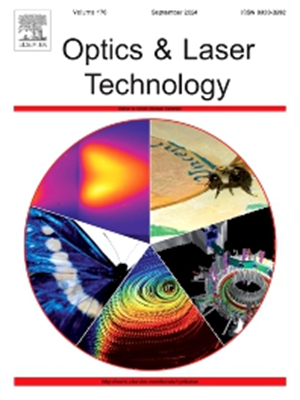一种可调谐双频铷法拉第激光器
IF 5
2区 物理与天体物理
Q1 OPTICS
引用次数: 0
摘要
具有特定频率间隔的双频激光器在几何测量、光微波产生、量子精密测量等方面有着重要的应用。本文报道了780 nm的DF铷法拉第激光器,其模式频率分别对应于85Rb和87Rb D2跃迁。两种激光模式产生的微波信号线宽为671 Hz,通过调节二极管电流可在4.7 ~ 4.95 GHz至5.94 ~ 6.7 GHz范围内进行调谐。此外,我们使用调制转移光谱将其中一种激光模式锁定到87Rb超精细跃迁,频率稳定性提高了近一个数量级。噪声特性也被测量,其中相位噪声被抑制超过25 dB在100 Hz偏移量与两个单模激光器的外差拍产生的微波信号。780 nm DF铷法拉第激光器具有两种频率与Rb跃迁相关的相干模式,为紧凑原子物理应用提供了一种有前途的便捷方法,如相干居群捕获钟、原子重力仪等。本文章由计算机程序翻译,如有差异,请以英文原文为准。
A tunable dual-frequency rubidium Faraday laser
Dual-frequency (DF) lasers with specific frequency intervals have crucial applications in geometric measurement, optical microwave generation, quantum precision measurement, etc. Here, we report a 780 nm DF rubidium Faraday laser, with two modes’ frequencies corresponding to the 85Rb and 87Rb D2 transitions. The microwave signal generated from the two laser modes’ beat has a linewidth of 671 Hz and is tunable from 4.7–4.95 GHz to 5.94–6.7 GHz by adjusting the diode current. Moreover, we use modulation transfer spectroscopy to lock one of the laser modes to the 87Rb hyperfine transition, and the frequency stability improves nearly an order of magnitude. The noise characteristics are also measured, where the phase noise is suppressed over 25 dB at 100 Hz offset compared to the microwave signal generated by two single-mode lasers’ heterodyne beat. This 780 nm DF rubidium Faraday laser has two coherent modes with frequencies related to Rb transitions, which provides a promising and convenient method for compact atomic physics applications, such as coherent population trapping clocks, atom gravimeters, and so on.
求助全文
通过发布文献求助,成功后即可免费获取论文全文。
去求助
来源期刊
CiteScore
8.50
自引率
10.00%
发文量
1060
审稿时长
3.4 months
期刊介绍:
Optics & Laser Technology aims to provide a vehicle for the publication of a broad range of high quality research and review papers in those fields of scientific and engineering research appertaining to the development and application of the technology of optics and lasers. Papers describing original work in these areas are submitted to rigorous refereeing prior to acceptance for publication.
The scope of Optics & Laser Technology encompasses, but is not restricted to, the following areas:
•development in all types of lasers
•developments in optoelectronic devices and photonics
•developments in new photonics and optical concepts
•developments in conventional optics, optical instruments and components
•techniques of optical metrology, including interferometry and optical fibre sensors
•LIDAR and other non-contact optical measurement techniques, including optical methods in heat and fluid flow
•applications of lasers to materials processing, optical NDT display (including holography) and optical communication
•research and development in the field of laser safety including studies of hazards resulting from the applications of lasers (laser safety, hazards of laser fume)
•developments in optical computing and optical information processing
•developments in new optical materials
•developments in new optical characterization methods and techniques
•developments in quantum optics
•developments in light assisted micro and nanofabrication methods and techniques
•developments in nanophotonics and biophotonics
•developments in imaging processing and systems

 求助内容:
求助内容: 应助结果提醒方式:
应助结果提醒方式:


